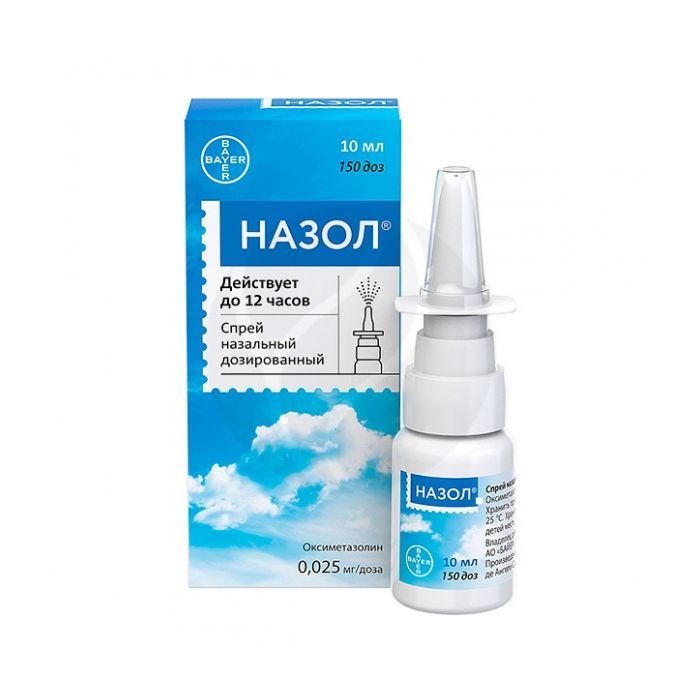Nazol spray 0.025%, 10ml
Expiration Date: 05/2027
Russian Pharmacy name:
Назол спрей 0.025%, 10мл
To facilitate nasal breathing when:
colds and viral infections of the upper respiratory tract
sinusitis and rhinitis of any etiology.
Intranasally.
1 dose contains 0.025 mg oxymetazoline hydrochloride.
Adults and children over 12 years old - 2-3 doses in each nasal passage 2 times a day.
Children from 6 to 12 years old - 1 dose in each nasal passage 2 times a day.
Do not use the drug more than 2 times a day.
Duration of treatment: it is not recommended to use the drug for more than 3 days. With frequent or prolonged use of the drug, the feeling of difficulty in nasal breathing may reappear or worsen. If these symptoms appear, you should stop treatment and consult a doctor.
When injecting, do not tilt your head back and do not spray while lying down.
Nasal spray 0.05% in the form of a clear, colorless solution, odorless.
100 ml
oxymetazoline hydrochloride 0.05 g
Excipients: benzalkonium chloride - 0.02 g, macrogol 400 - 7.5 g, povidone - 0.4 g, propylene glycol - 7.5 g, sodium hydrogen phosphate dihydrate - 0.006 g, sodium dihydrogen phosphate dihydrate - 0.65 g, disodium edetate dihydrate - 0.1 g, hydrochloric acid conc. - 0.003 g, purified water - 85.571 g.
Hypersensitivity to the drug or its components;
atrophic rhinitis;
children under 6 years of age;
pregnancy;
lactation period.
The drug should be used with caution in patients suffering from diseases of the cardiovascular system (arterial hypertension, ischemic heart disease, chronic heart failure, tachycardia, arrhythmias), impaired carbohydrate metabolism (diabetes mellitus), thyroid function (hyperthyroidism), pheochromocytoma, chronic renal failure, hyperplasia of the prostate gland (urinary retention) and angle-closure glaucoma, taking MAO inhibitors, tricyclic antidepressants.
pharmachologic effect
Oxymetazoline belongs to the group of topical alpha-adrenostimulants. Has a vasoconstrictor effect. When administered intranasally, it reduces the swelling of the mucous membrane of the upper respiratory tract, which leads to relief of nasal breathing and the opening of the mouths of the paranasal sinuses and Eustachian tubes. The effect of the drug is manifested in 10-15 minutes after application and lasts for 10-12 hours.
Side effect
Sometimes burning or dryness of the nasal membranes, dryness in the mouth and throat, sneezing, increased volume of secretions from the nose.
In rare cases, after the effect of the drug has passed, a strong feeling of 'stuffiness' of the nose (reactive hyperemia).
Side effects due to the systemic effect of the drug: increased blood pressure, headache, dizziness, palpitations, increased anxiety, nausea, insomnia.
With prolonged use of the drug (more than 7 days), the following are possible: reactive hyperemia of the nasal mucosa, atrophy of the nasal mucosa, tachyphylaxis (a rapid decrease in the therapeutic effect with repeated use).
Application during pregnancy and lactation
The drug is contraindicated for use during pregnancy and lactation (breastfeeding).
Application during pregnancy and breastfeeding is possible only if the intended benefit to the mother outweighs the possible risk to the fetus or infant.
Application in children
Contraindicated: children under 6 years of age.
special instructions
Use in the recommended dosage without consulting a doctor for no more than 3 days. Avoid contact with eyes.
In order to avoid the spread of infection, it is necessary to use the drug individually.
Overdose
Prolonged or frequent use of the drug in the nasal cavity can cause nausea, increased blood pressure, tachycardia, and CNS depression.
Symptomatic treatment
Drug interactions
With simultaneous use with MAO inhibitors (including a period within 14 days after their cancellation) and tricyclic antidepressants, an increase in blood pressure may be observed.
The drug slows down the absorption of local anesthetic drugs, lengthens their effect.
The co-administration of other vasoconstrictor drugs increases the risk of side effects.

